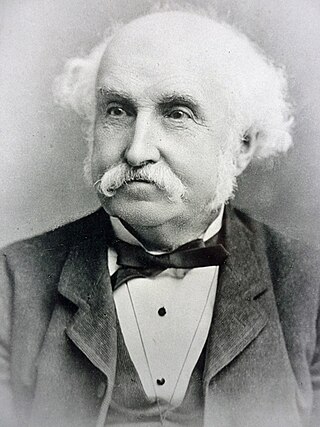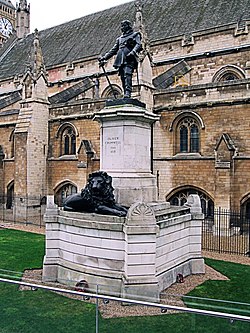
Oliver Cromwell was an English statesman, politician and soldier, widely regarded as one of the most important figures in the history of the British Isles. He came to prominence during the 1639 to 1653 Wars of the Three Kingdoms, initially as a senior commander in the Parliamentarian army and latterly as a politician. A leading advocate of the execution of Charles I in January 1649, which led to the establishment of The Protectorate, he ruled as Lord Protector from December 1653 until his death in September 1658. Cromwell remains a controversial figure due to his use of the army to acquire political power, and the brutality of his 1649 campaign in Ireland.

George Monck, 1st Duke of Albemarle KG PC JP was an English soldier, who fought on both sides during the Wars of the Three Kingdoms. A prominent military figure under the Commonwealth, his support was crucial to the Restoration of Charles II in 1660, who rewarded him with the title Duke of Albemarle and other senior positions.

Sir William Hamo Thornycroft was an English sculptor, responsible for some of London's best-known statues, including the statue of Oliver Cromwell outside the Palace of Westminster. He was a keen student of classical sculpture and was one of the youngest artists to be elected to the Royal Academy, in 1882, the same year the bronze cast of Teucer was purchased for the British nation under the auspices of the Chantrey Bequest.

Sir Hardress Waller, c. 1604 to – 1666, was born in Kent and settled in Ireland during the 1630s. A first cousin of Parliamentarian general William Waller, he fought for Parliament in the Wars of the Three Kingdoms, becoming a leading member of the radical element within the New Model Army. In 1649, he signed the death warrant for the Execution of Charles I, and after the Stuart Restoration in 1660 was condemned to death as a regicide.

The Commander-in-Chief of the Forces, later Commander-in-Chief, British Army, or just the Commander-in-Chief (C-in-C), was (intermittently) the professional head of the English Army from 1660 to 1707 and of the British Army from 1707 until 1904. In 1904 the office was replaced with the creation of the Army Council and the appointment of Chief of the General Staff.

Colonel John Hewson, also spelt Hughson, was a shoemaker from London and religious Independent who fought for Parliament and the Commonwealth in the Wars of the Three Kingdoms, reaching the rank of colonel. Considered one of Oliver Cromwell's most reliable supporters within the New Model Army, his unit played a prominent part in Pride's Purge of December 1648. Hewson signed the death warrant for the Execution of Charles I in January 1649, for which he reportedly sourced the headsman, while soldiers from his regiment provided security.

The Westminster Assembly of Divines was a council of divines (theologians) and members of the English Parliament appointed from 1643 to 1653 to restructure the Church of England. Several Scots also attended, and the Assembly's work was adopted by the Church of Scotland. As many as 121 ministers were called to the Assembly, with nineteen others added later to replace those who did not attend or could no longer attend. It produced a new Form of Church Government, a Confession of Faith or statement of belief, two catechisms or manuals for religious instruction, and a liturgical manual, the Directory for Public Worship, for the Churches of England and Scotland. The Confession and catechisms were adopted as doctrinal standards in the Church of Scotland and other Presbyterian churches, where they remain normative. Amended versions of the Confession were also adopted in Congregational and Baptist churches in England and New England in the seventeenth and eighteenth centuries. The Confession became influential throughout the English-speaking world, but especially in American Protestant theology.

The Second Protectorate Parliament in England sat for two sessions from 17 September 1656 until 4 February 1658, with Thomas Widdrington as the Speaker of the House of Commons. In its first session, the House of Commons was its only chamber; in the second session an Other House with a power of veto over the decisions of the Commons was added.

Mary Thornycroft was a British sculptor who sculpted many different busts, fragments and statues. She frequently choose infants and children as her subjects and was commissioned by Queen Victoria to create a number of statues and portraits of her children and other members of the royal family. Several of these are now in the British Royal Collection.

Thomas Thornycroft was an English sculptor and engineer.
Events from the year 1657 in England.
Theresa Thornycroft was an English sculptor and painter.

The statue of George V in Old Palace Yard, Westminster, London, is a sculpture of George V, King of the United Kingdom and the British Dominions, and Emperor of India. The statue was sculpted prior to the Second World War and was hidden in a quarry during the war years. Other locations were suggested for the statue, including Parliament Square, but it was unveiled opposite the House of Lords in 1947.

Boadicea and Her Daughters is a bronze sculptural group in London representing Boudica, queen of the Celtic Iceni tribe, who led an uprising in Roman Britain. It is located to the north side of the western end of Westminster Bridge, near Portcullis House and Westminster Pier, facing Big Ben and the Palace of Westminster across the road. It is considered the magnum opus of its sculptor, the English artist and engineer Thomas Thornycroft. Thornycroft worked on it from 1856 until shortly before his death in 1885, sometimes assisted by his son William Hamo Thornycroft, but it was not erected in its current position until 1902.
A statue of Oliver Cromwell stands on Market Hill in St Ives, Cambridgeshire, England. It is a sculpture of Oliver Cromwell, Lord Protector of the Commonwealth of England, Scotland and Ireland. The statue was designed by F. W. Pomeroy and erected in 1901. The statue is one of five public statues of Cromwell in the United Kingdom and is Grade II listed for its architectural merit.

A statue of Oliver Cromwell stands on Bridge Street in Warrington in Cheshire, England. It is a sculpture of Oliver Cromwell, Lord Protector of the Commonwealth of England, Scotland and Ireland. The statue was designed by John Bell and erected in 1899. The statue is one of four public statues of Cromwell in the United Kingdom and has been Grade II listed since September 1973 for its architectural merit.

The Thames Ditton Foundry was a foundry in Thames Ditton, Surrey, which operated from 1874 to 1939 and which under various owners produced numerous major statues and monuments as one of the United Kingdom's leading firms of bronze founders.

A bronze statue of General Charles George Gordon by Hamo Thornycroft stands on a stone plinth in the Victoria Embankment Gardens in London. It has been Grade II listed since 1970. A similar statue stands at Gordon Reserve, near Parliament House in Melbourne, Australia, on its original tall plinth.

John Webb Singer was an English businessman who created a substantial art foundry in Frome, Somerset, known for its statuary and ecclesiastical products. He had assembled immense collections of antique jewellery, rings, wine glasses, snuffboxes, stamps. He took a prominent part in both local and national politics, serving on the Local Board and its successor the Urban District Council, founding the Frome Art School and helping to create the Frome Literary and Scientific Institution. He worked with the leading bronze sculptors of his day.

The Gladstone Memorial on the Strand, London is a bronze sculpture of the British statesman, created by Hamo Thornycroft between 1899-1905. The statue was erected as the national memorial to Gladstone and shows him in the robes of the Chancellor of the Exchequer. The figure stands on a plinth surrounded by allegorical figures depicting four of the Virtues, Courage, Brotherhood, Education and Aspiration. The memorial is a Grade II listed structure.


















